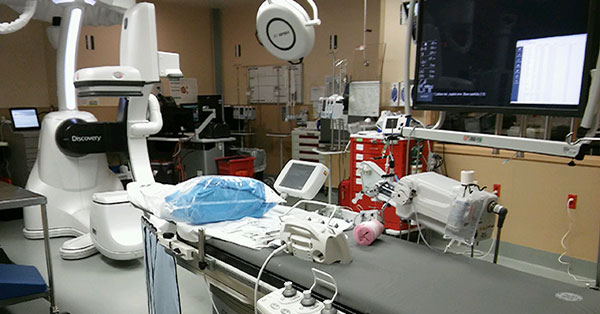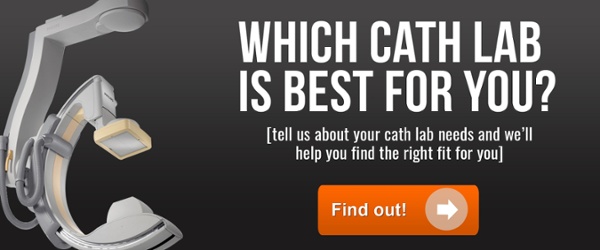
In early 2012, GE reinvigorated their cath lab product line by replacing the long-running Innova X100 series (2100,3100,4100) with the new Innova IGS 5 (520,530,540) series. Later that same year, GE unveiled their new IGS 7 (730,740) series cath labs featuring the new Advanced Guided Vehicle, or AGV, positioner gantry.
While the IGS 5 and IGS 7 series have a lot in common when it comes to tubes, detectors, chillers, and computers, there are a couple of major differences that set the two apart from one another. Today, we're going to break those differences down.
AGV Positioner Gantry
The biggest, and most obvious difference between the IGS 5 and IGS 7 labs is their gantry positioner styles. The positioner for the IGS 5 series is mounted to the floor of the OR in the traditional fashion. The positioner for the IGS 7 series, the AGV, isn't mounted at all. Think of it as a giant mobile C-arm.
The AGV positioner brings IGS 730 and 740 labs the functional familiarity of GE's floor-mounted gantries but adds the ability to wheel the gantry out of the way for full, unencumbered access to the patient table. The system uses a laser guidance system and mirrors mounted around the room to track its position at all times.
The AGV swivels around the table when in position for imaging, and can have 10+ preset locations to move the system, including parked positions, for when imaging is not needed. Table-side controls let the user back the gantry away from the table and into a parked position with the touch of a single button.
Table Options
The other big difference between the IGS 5 and IGS 7 series systems is their table options. The IGS 5 series has several table options available, depending on your needs. These include the Omega IV, Omega V, Innova IQ V3, or Innova IQ V4.
The Omega tables feature vertical and end-to-end movements. The Omega V is 33cm longer than the IV, making it more suitable for angiography. The Innova IQ tables feature tilting movement capabilities.
Meanwhile, the IGS 7 series offers just two table options: the Innova IQ V3 or the OR variant, which features the Maquet Magnus table. The high articulation of the Magnus table, along with its assortment of interchangeable tabletops, makes it an extremely flexible option for all types of procedures, from cardiology, to vascular, to neurosurgery, and more.
The Takeaway
Presently, neither the IGS 5 series nor the IGS 7 series are common on the secondary market. Only the first few are beginning to creep into availability. That said, as they continue to emerge, expect higher prices on IGS 7 labs than IGS 5.
Because the imaging chain and software features are the same, users can expect the same level of image performance across both series. Facilities with more "bread and butter" caseloads and moderate volume can be served well by the IGS 520, 530, or 540 and save significant dollars. Facilities that have more mixed use across specialties and/or high volume will benefit greatly from the workflow and efficiency advantages of the IGS 730 or 740, but will need greater latitude in their capital equipment budgets to do so.

Kenn Dextrom
Kenn Dextrom is the Director of Product Manager at Block Imaging. He aims to provide clear direction and careful planning for Interventional Cath Lab buyers and working with the Block Imaging product team to provide excellent solutions for our customers. Out of the office, he spends most of his time keeping up with his wife and their three energetic sons.






